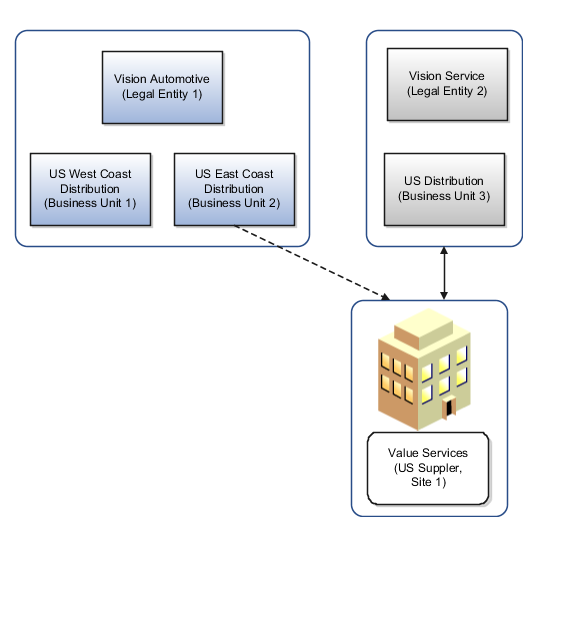Example of How to Create a Purchase Order for Another Legal Entity
You can increase operational efficiency by allowing a legal entity to procure goods and services for another legal entity without having to produce formal intercompany buy and sell documentation. In this case there is no integration with Oracle Fusion Supply Chain Financial Orchestration.
Scenario
The Vision Service, US Distribution unit, orders a service from a favored supplier, Value Services. Vision Service has the service delivered to Vision Automotive, East Coast Distribution unit.
This figure shows the transaction in a flow diagram. The requesting entity is Vision Automotive, US East Coast Distribution unit. They are legal entity 1, business unit 2. The ordering entity is Vision Service, US Distribution unit. They are legal entity 2, business unit 3. The supplier is Value Services. They are US supplier site 1. As a result, legal entity 1 receives services from a supplier that are ordered by legal entity 2.

Need for Multiple Legal Entities
Enterprises often have multiple legal entities across countries and at times multiple legal entities are registered even within a country. In order to be cost effective, members of closely related legal entities devise ways to take advantage of scale. A few ways they achieve this are; by enabling one legal entity to procure goods on behalf of several other related legal entities and thus benefiting from volume purchases or by channeling purchases for resale through legal entities located in favorable tax jurisdictions, resulting in lower effective tax rates on corporate financial statements.
The following prerequisite is required:
-
Allow Multiple Legal Entities on Order is set to Allow on the Configure Requisitioning Business Process page.
Create the Purchase Order
The buyer creates a purchase order in legal entity A (header sold-to legal entity) but there are schedules that have ship-to organizations pointing to legal entity A and B. The balancing segment on the account will correspond to legal entity A. Intercompany Payables and Receivables invoices aren't be created in this case. However, intercompany journal entries are created in the general ledger once the transaction is accrued.